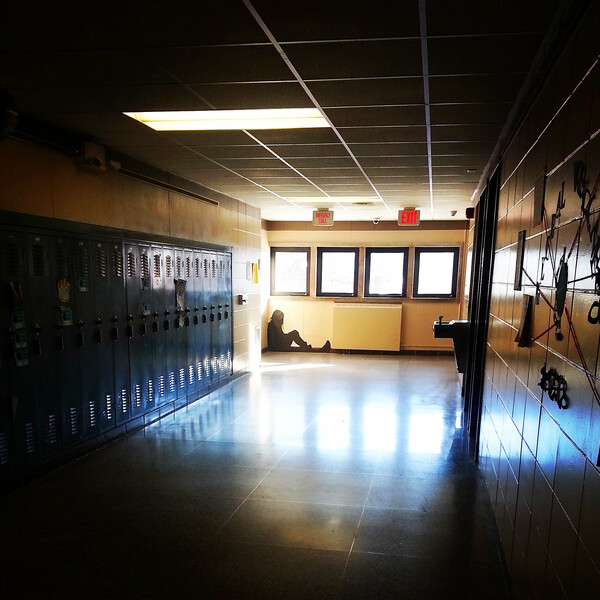While I was teaching at a public middle school several years ago, our school was faced with an epidemic of bullying and student marginalization. The staff developed several schoolwide campaigns aimed at addressing the problems. In my art class, I asked my 8th grade students to construct life-sized installations of bullying and anti-bullying scenarios inspired by the work of artist Kara Walker. They used traced silhouettes of their own bodies on black paper to tell personal stories.
One student, Breanna, spent several days sitting at her table, isolated from the other groups (which was typical for her). Eventually, I asked if she had any ideas for the project. "Yeah," she said, "but I don't think you'll let me do what I want because it's not like everyone else's."
"Try me," I said.
Her idea was worth the wait. She wanted me to help her trace her silhouette the way she usually sat, singularly slumped over and hidden in plain sight in the hallways. It was a striking idea, and after the silhouette narratives were installed by the students around the school, Breanna's ended up being the most expressive and personal of the entire class. I was embarrassed that I had first assumed she wasn't engaged in the project. It was a teaching moment for me to learn that students who feel marginalized sometimes need additional time to process and feel comfortable sharing.
In the first week of the project's month-long display, the installations were vandalized almost daily. This school had a recurring issue with bullying behaviors, leaving many students in constant states of tension, reaction, confrontation, and marginalization. However, my art students remained determined. Several of them volunteered to make repairs to the installations at the beginning of class each day. By keeping the pieces safe and cleaning them up, our class sent a message that we were not going to be silenced.
As time passed, these installations became a revered part of the school culture and began to make an impact on students' attitudes toward bullying and being marginalized. The destructive reactions toward the installations waned and eventually stopped completely. My students were able to create a deliberate pause in the school culture through their persistence. And although the pause wasn't planned, it became powerful evidence of the project's impact. You can't change a school's culture overnight, but these symbols helped unify students behind a cause and begin a new culture of acceptance and belonging rather than conformity and bullying.
Our culture, whether we realize it or not, values homogeneity or "sameness." Students who "fall between the cracks" socially or academically may withdraw, self-segregate, or be bullied. Students who identify as a minority, whether by race, culture, religion, sexual orientation, gender, socio-economic status, appearance, or other qualities, may be unable to move past the trauma of not feeling accepted. These students may be failing not only academically, but also in realizing their own creative potential.
Students see almost everything through an autobiographical lens. Art projects that are centered on authorship, voice, and redesign offer students a distinctly more creative, choice-based, and individualized learning platform. With the creation of those targeted silhouette narratives made in response to significant student social issues, my students were able to represent themselves as important authors actively invested in sharing their perspectives and promoting new ways of thinking.
Middle-school art students in Lisa Lenarz's class displayed silhouettes of themselves at the ends of hallways, in bathrooms, and in other school locations that showcased how bullying and marginalization affected them.
Photos by Lisa M. Lenarz









